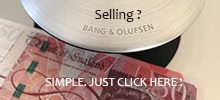Bang & Olufsen Two Way Communication

Two-way remote controls
From slide-rule to electronic sophistication
The slide rule function, which symbolised a precision never seen before, allowed Bang & Olufsen music systems of the late 1960s and early 1970s to convey their settings in a way that no other product had done so previously.
Jacob Jensen's designs of such classics as Beomaster 1200 and Beocord 1100 allowed users to see volume levels and tuning functions from some distance away. This clear, concise method became the first example of two-way communication – a feature which B&O refined still further through their sophisticated remote controls throughout the 1980s and 1990s. At first it was the large LEDs of such products as Beocenter 5000 and Beomaster 6000 which allowed the user the view the state of play from across a room, as the numbers sloped towards you, followed later by electronic visualisation through hand-held remote-control terminals.
Imagine a remote-control which spoke back to you. Imagine a remote-control which confirmed that your commands had been carried out. Imagine a remote-control that gave you visual feedback of your instructions and reconfirmed these every time you pressed a button on your Bang & Olufsen Beolink 5000 or Beolink 7000.
This interactive remote-control system was around from 1985 to the mid-1990s when two-way communication was in use in the majority of Bang & Olufsen's audio and video products.
The first product to use two-way communication was in the innovative Beosystem 5000, designed by Jacob Jensen. Its remote control terminal - Master Control Panel 5000 (MCP5000) - was used for instructing Beomaster 5000 to follow out your commands, and in turn, Beomaster 5000 confirmed your instructions by instantly sending signals back to your MCP5000 so that you could see that they had been carried out. Further, by using Bang & Olufsen's Master Control Link (MCL) around the house in a Beolink® system, the Panel could enact your instructions and confirm that they had been initiated through the Beolink® two-way MCL wall sensor.
Two-way communication progressed throughout the 1980s with Beosystems 5500, 6500 and 7000 when the one-way remote control - Beolink 1000 - was introduced to complement the other terminals in the family. However, it was necessary to use either Beolink 5000 or the more sophisticated Beolink 7000, to receive visual feedback of your commands, for products not equipped with their own MCPs.
So what was Two-way Communication?
Two-way operation and exchange of data: a command was issued from the Beolink 5000 or 7000 when you activated a key. The command was received by the two-way audio/video product and the processed command was relayed to the source via Datalink. A confirmation was then sent all the way back to the remote-control to update the panel.
What were its benefits?
Instant feedback of the source being played was the obvious benefit. However, programming a video recorder (such as the VX7000 with either the MX6000 or MX7000) was made so much easier if the VCR was communicating with you real-time. It was just then a simple matter of answering the timer questions and having them confirmed with you at each stage. Linked with this, if a hi-fi or video was situated a long way from you and you found it difficult to read the tracks numbers, Beolink 5000 and Beolink 7000 made it so much easier. At night, Beolink 5000 and 7000 made the task of using your remote control a lot easier. Beolink 7000 of course, illuminated the information in red LEDs; with Beolink 5000 it was just a case of hold up the transparent readout to a light source (say, a TV screen) so that you could easily make out the readout. With Beo4 of course, this is not so easy, as each time you need to use it, you either have to remember which button to press (with 'List' this is almost an impossibility) or else turn on a lamp each time you wish to use it.
Not only audio and video products could be used via two-way communication. Light sources - through the LC2 light control unit - could be controlled with such products as Beocenter 9500, which could be programmed to turn on or off the LC2 unit at any given time, and at any given light setting. With one-way products this is impossible as it was the products themselves which sent out the infra-red digital instructions, rather than the remote control terminals.
What products could use two-way communication?
In addition to the Beosystems which used two-way communication, many other video and audio products utilised the same system, including:
Audio Products
Video Products
Televisions:
VCRs (used in conjunction with relevant Beovision)
Many of these products however, used two-way communication for just a portion of their lifetime. When purchasing any of the above second-hand, it is always advisable to check on the 'type' number of the product concerned. Those manufactured in the early 1990s may well have been manufactured with the 'two-way chip'; since the demise of two-way remote controls, products may well have been manufactured to function just as one-way units.
Which remote controls could be used?
Beolink 5000 and Beolink 7000 were the two main remote control terminals (used on many of the above audio and video systems); however Master Control Panels 5000, 5500 and 6500 also offered two-way visual feedback for their respective Beosystems.
Why did Bang & Olufsen abandon the use of two-way communication?
The company says that it ended as a consequence of the two-way feedback slowing down use of the remote controls. However, in practice, any time delay was minimal. The benefits far outweighed its disadvantages (if there were any). The system officially ended with the introduction of the Beo4 remote control terminal in 1994. No other manufacturer of hi-fi and video products has ever come near the products created by Bang & Olufsen with two-way capabilities. Perhaps one day the technology will be looked at again.
What are the legacies of two-way communication?
None, really, After the demise of two-way remote control terminals and active speakers with displays, the only product left was BeoLab 3500. No other two-way products are currently manufactured (2004).
Two-way operation:
When you touch a button on the Beolink 5000 terminal, an IR command is issued and a cue is read out in the display to confirm that you have activated the button. The Beovision receives the command, the microprocessor processes it and relays it to the proper source where the command is carried out. The source confirms that the operation is carried out - or, if the command cannot be carried out, sends a message back telling why. The confirmation is then processed in the TV before being fed back to the Beolink 5000 where the display reads out the correct cue. This invisible procedure means that all you have to do is to press the source button - the system does the rest.
This automatic rerouting and processing of operation commands inside the system is a result of your operation. Apart from this operation level there is also an automated function level in the system: automatic transfer of vital data from one component to the others, in order to minimise the tedious work in setting up the video system.
Video System 5500 - Product Information 1991/92
Created: 11th January 2007
Modified: 3rd April 2007


